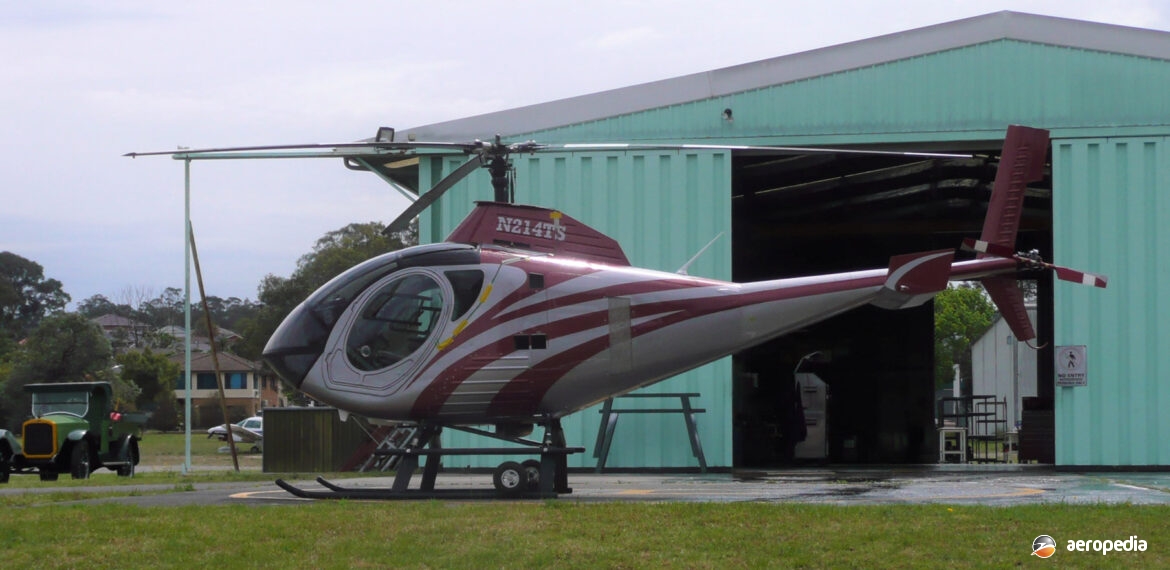Photograph:
Schweizer 330 N214TS (c/n c0073A) at Bankstown, NSW in October 2018 (Warwick Bigsworth)
Country of origin:
United States of America
Description:
Turbine-powered utility and training helicopter
Power Plant:
One 209 kw (280 hp) Allison 250-C20W turboshaft
Specifications:
- Length: 9.51 m (31 ft 2 in)
- Rotor diameter: 8.38 m (27 ft 6 in)
- Tail rotor diameter: 1.3 m (4 ft 3 in)
- Height: 3.34 m (10 ft 11 in)
- Main rotor disc area: 55.3 m² (595 sq ft)
- Max speed: 222 km/h (138 mph)
- Cruising speed: 194 km/h (121 mph)
- Rate of climb: 421 m/min (1,380 ft/min)
- Range: 561 km (349 miles)
- Service ceiling: 3,962 m (13,000 ft)
- Empty weight: 1,156 kg (2,550 lb)
- Payload: 567 kg (1250 lb)
- Loaded weight: 1156 kg (2550 lb)
History:
In the mid-1950s the Hughes Tool Company’s aircraft division set about designing a light, two-seat, low-cost helicopter for utility work and training operations, producing the Model 269, the prototype of which flew for the first time on 2 October, 1956. Certification was received from the American FAA in April 1959 and it entered production with what later became Hughes Helicopters. The machine was popular and captured a good part of the market. It was soon in use in agricultural work and with police departments in the United States.
It received some development to the Model 269A and the slightly larger Model 269B. There subsequently was a name change to Hughes 300C, which also became known as the Model 269C. All these models were powered by piston engines. In 1983 the type was produced by Schweizer-Hughes, and later Schweizer. The Company in 2004 was purchased by Sikorsky Aircraft and the Model 300C became known as the Sikorsky S-300C. Over the years more than 3,000 examples have been produced.
In due course two turbine-powered models were developed from the Model 300 series and these became known as the Schweizer 330 and 333. The Model 330 was announced in 1987 and used the basic components, controls and systems of the 300C but had a redesigned fuselage and was fitted with an Allison 250-C10A engine, the prototype, a conversion of a 300C, flying for the first time on 14 June 1988 and FAA certification being received in September 1992.
In May 1997 the Model 330SP was introduced and this had an improved rotor and higher landing skids, the latter being able to be retrofitted to earlier turboshaft powered models. This variant had the Allison 250-C20W engine which was de-rated to 165 kw (220 hp) in order to provide better hot and high performance, the engine being able to maintain power up to 5,486 m (18,000 ft). Accommodation was provided for a pilot and two or three passengers.
An improved model known as the 333 was later produced, this being a development of the 330SP with new dynamic systems, rotor blades, a larger diameter rotor, higher weights and better all-round performance. The company eventually produced an upgrade kit for the Models 330 and 330SP. A new model later became available in 2008 known as the Sikorsky S-434 which utilised some of the developments made in order to produce the RQ-8A series for military purposes.
A development of the series is the Northrop Grumman MQ-8B Fire Scout, an unmanned variant of the 330 series with a new fuselage, fuel system and range of electronics and sensors, having a four-blade main rotor, which has been developed for the United States Navy as the RQ-8 series. This has been undergoing testing for some years on board the amphibious transport ship Nashville, a ship of the Austin-class.
In late 2018 a Model 330 arrived at Bankstown, NSW, this aircraft having been registered N214TS (c/n 0073A) and owned in the United States by Aircraft Guarantee Corp Trustee of Onalaska, Texas. It was built in 2008 and its Certificate of Registration was issued on 29 May 2018. It was fitted with a Rolls Royce 250-C20W engine. However by early 2020 it had not been placed on the Australian Civil Aircraft Register and shortly thereafter it was exported.

